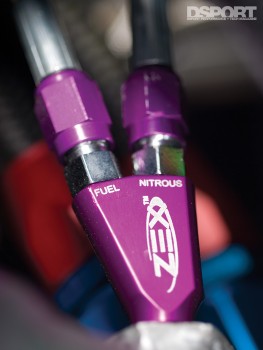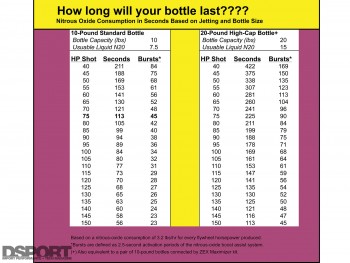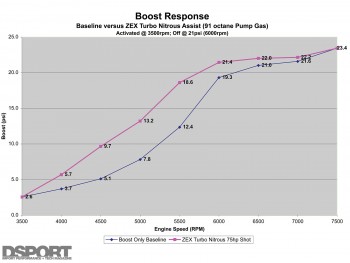More power at the push of a button. We’ve all been in a situation where we wished we could just floor the throttle, hit a button and have an extra 50, 100 or 150 horsepower to break-off an opponent while our car accelerates quicker than ever before. What sounds like a dream is a reality with a properly-installed nitrous-oxide injection system. The proper use of nitrous-oxide injection delivers significant performance increases on both naturally-aspirated and forced-induction vehicles. However, a thorough understanding of nitrous-oxide injection is paramount to having a problem-free experience.
Text by Michael Ferrara // Photos by Dino Dalle Carbonare and DSPORT Staff
DSPORT Issue #148
The Good, The Bad, The Ugly
 The good news is that dollar for dollar, the horsepower increase from a properly installed nitrous-oxide system is difficult to beat. Most starter systems come ready to generate an additional 30 to 120 horsepower. Above this power level, a more sophisticated system is generally required and previous experience with nitrous oxide is highly suggested.
The good news is that dollar for dollar, the horsepower increase from a properly installed nitrous-oxide system is difficult to beat. Most starter systems come ready to generate an additional 30 to 120 horsepower. Above this power level, a more sophisticated system is generally required and previous experience with nitrous oxide is highly suggested.
The bad news is that an improperly installed nitrous-oxide system can cause severe engine damage. If nitrous oxide is injected into the engine without supplying an adequate amount of fuel (or no fuel at all), then you’ll have trouble. The temperatures in the combustion chamber will skyrocket. The engine may experience detonation and spark plugs, valves or pistons may even melt. For safe nitrous-oxide use, tuners need to be realistic in the level of additional horsepower that they “jet” the nitrous-oxide system to produce. For example shooting too much nitrous-oxide and fuel into a completely- stock D16 engine (more than a 50-horsepower shot) will exceed the power handling capabilities of the factory shortblock. The result will be a blown engine. Fortunately, a properly-installed system that is jetted for a power gain that’s appropriate for the power-handling capabilities of the engine avoids these pitfalls. There are some ugly facts that you’ll have to face when it comes to using a nitrous-oxide system. First, bottles are only so big. The more frequently you “squeeze”, the more times you will be refilling the bottle. Second, the less you know about nitrous, the more likely you are to have a bad experience. Third, and most importantly, it is not the use of nitrous oxide that causes engine damage, it is the misuse of nitrous oxide by the tuner and driver. While “jetting” most nitrous systems for additional power is usually a simple five-minute affair, this can get some horsepower-greedy enthusiasts in trouble. As we mentioned earlier, every engine has its limit. A stock engine doesn’t have the toughness of a racing engine. Chances are there is a tuner out there with your same engine and they have experience with using nitrous oxide on your particular engine. If they tell you that a 40-horsepower shot is all that you can do on a stock D16, believe them.
Magic of Nitrous Oxide
Hit a button and the engine produces 50, 100, 150 or more additional horsepower. Is it magic? Not really. The explanation is rather simple. But before we understand how a nitrous-oxide system allows an engine to generate a rush of additional horsepower, it’s best to review how the engine itself makes power.
Internal combustion (IC) engines are designed to convert one form of energy to another. An IC engine takes the chemical energy in the fuel and then, through combustion (the controlled burning of the air-fuel mixture), the fuel’s energy is turned into thermal energy. This thermal energy is then turned into kinetic energy (motion energy) at the flywheel. If you can’t remember each stage, all that you need to remember is that the more fuel you can combust, the more power you can make.
So this takes us to combustion. What do we need to be able to burn more fuel? The answer is simple, as just two things are needed. First, we need a way to add more fuel. Second, we need something that will supply an additional amount of oxygen to let the fuel burn.
Regardless of who manufactures the nitrous-oxide system, every system accomplishes both of the above. In some way, either through the factory injectors or by adding additional fuel nozzles, the nitrous-oxide system puts more fuel into the engine. The additional amount of oxygen needed to burn this fuel is also supplied by the nitrous-oxide system. The additional oxygen is supplied by injecting gaseous nitrous oxide into the engine. When the nitrous oxide enters the engine, it supplies additional oxygen for combustion. The air that we breathe is about 21-percent oxygen. On the other hand, nitrous oxide contains 36-percent oxygen by weight. This means that nitrous oxide can supply about 70-percent more oxygen than standard air. This additional supply of oxygen is one way that the nitrous-oxide injection allows additional power production. In addition to this aspect, there is also another characteristic of nitrous-oxide injection that results in power gains. Since the nitrous oxide changes from a liquid to gaseous phase during the injection process, a significant cooling effect will result. It is not uncommon for the air intake charge temperatures to be reduced by 75 or more degrees (Fahrenheit). Since an 11-degree drop in intake air temperature generally results in a one percent increase in power production (due to the increased density of the air-fuel charge), this temperature reduction by itself would increase the power output by almost seven percent.





